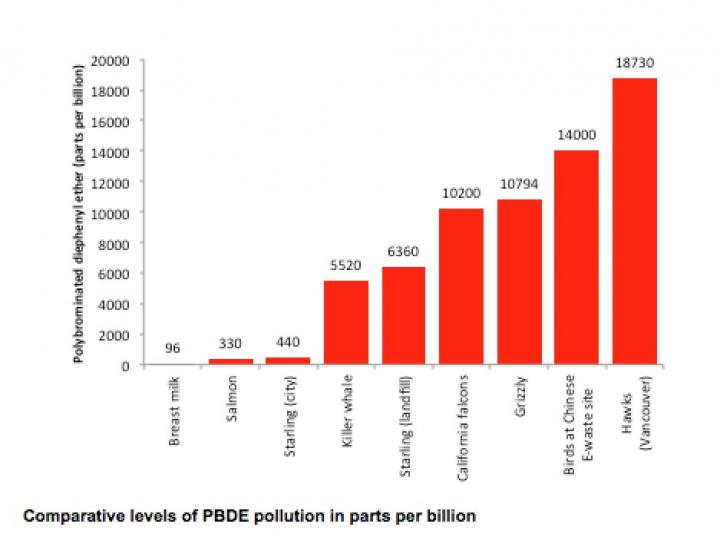Flameproof falcons and hawks

A Canadian research team has discovered the most polluted wild bird found anywhere in the world. Credit: Kyle Elliott
A Cooper's hawk, found in Greater Vancouver, is the most polluted wild bird that has been found anywhere in the world. A team of Canadian researchers made this startling discovery while analyzing liver samples from birds of prey that were discovered either injured or dead in the Vancouver area.
The levels of polybrominated diphenyl ethers (PBDEs) in the contaminated Cooper's hawk were 196 parts per million, significantly higher than those recorded in birds found either in cities in California or in an electronic waste site in China. PBDEs are a group of chemicals that act as flame retardants and were once used widely in computers, stereos, televisions, vehicles, carpets and furniture.
Although many of the PBDEs have been banned since the 2000s in Canada, they continue to accumulate in landfill sites where people dispose of PBDE-rich items. In British Columbia's Fraser River delta, for example, the quantity of PBDEs has doubled every four years over the past four decades. This can have a significant effect on the bird populations that live nearby.
“Many animals, including coyotes, eagles and hawks benefit from the excess food in our cities. A downside is the high levels of pollution. The levels of flame retardants in starlings, a favourite prey of hawks, which nested near the landfill site were fifteen times higher than levels in starlings found elsewhere in Vancouver,” says Prof. Kyle Elliott, of McGill's Department of Natural Resource Sciences, one of the authors of the study which was recently published in the journal Science of the Total Environment.
“We were surprised to see such high levels of contaminants in what I think of as 'green' city. We can only hope that because many forms of PBDEs have now been banned and the levels of these contaminants are rapidly disappearing from herons and cormorants in Vancouver, the same will be true for other bird species.”
###
The research team: Environment Canada, Simon Fraser University, the University of Windsor, McGill University.
To contact the researcher directly: kyle.elliott@mcgill.ca
Media Contact
All latest news from the category: Life Sciences and Chemistry
Articles and reports from the Life Sciences and chemistry area deal with applied and basic research into modern biology, chemistry and human medicine.
Valuable information can be found on a range of life sciences fields including bacteriology, biochemistry, bionics, bioinformatics, biophysics, biotechnology, genetics, geobotany, human biology, marine biology, microbiology, molecular biology, cellular biology, zoology, bioinorganic chemistry, microchemistry and environmental chemistry.
Newest articles

First-of-its-kind study uses remote sensing to monitor plastic debris in rivers and lakes
Remote sensing creates a cost-effective solution to monitoring plastic pollution. A first-of-its-kind study from researchers at the University of Minnesota Twin Cities shows how remote sensing can help monitor and…

Laser-based artificial neuron mimics nerve cell functions at lightning speed
With a processing speed a billion times faster than nature, chip-based laser neuron could help advance AI tasks such as pattern recognition and sequence prediction. Researchers have developed a laser-based…

Optimising the processing of plastic waste
Just one look in the yellow bin reveals a colourful jumble of different types of plastic. However, the purer and more uniform plastic waste is, the easier it is to…



